The Coastal plain swamp macrogroup consists of the following habitats:
North Atlantic Coastal Plain Basin Peat Swamp
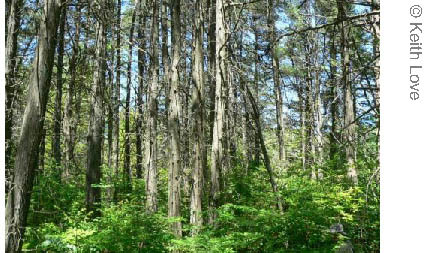

Regional distribution:
CT, DE, MA, MD, ME, NH, NJ, NY, RI. 58,301 total acres of habitat, of which 53.5% is conserved.
Description:
A forested swamp of peat-accumulating basins in the coastal plain from southern Maine down to the Delmarva Peninsula. Atlantic white cedar is characteristic and often dominant; red maple may also be an important species, especially after
logging. Black spruce is occasional in examples in the northern part of the region. Herbaceous species are typically more abundant than dwarf shrubs in the understory, which includes alder, great laurel, high-bush blueberry, winterberry, swamp azalea, and sphagnum moss. The saturated hydrology is evidenced by sphagnum-based hummock-andhollow microtopography.
Download the
pdf for this habitat for information about species, crosswalks to state names, and condition of this habitat.
North Atlantic Coastal Plain Basin Swamp and Wet Hardwood Forest
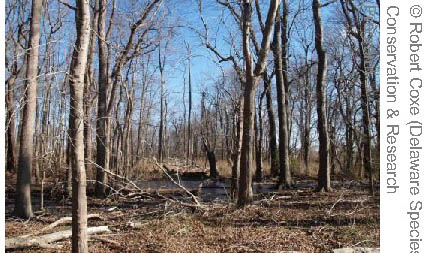

Regional distribution:
DC, DE, MD, NJ, NY, PA, RI, VA. 974,772 total acres of habitat, of which 18.9% is conserved.
Description:
A basin hardwood swamp of seasonally flooded coastal plain habitats from Long Island south to Virginia. Characteristic tree species include red maple, sweet gum, black gum, willow oak, and green ash. Loblolly pine is not uncommon south of Delaware Bay. Although supporting some seepage indicators, it is also affected by overland flow.
Download the
pdf for this habitat for information about species, crosswalks to state names, and condition of this habitat.
North Atlantic Coastal Plain Pitch Pine Lowland
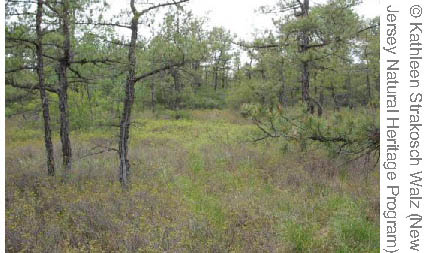

Regional distribution:
NJ. 178,521 total acres of habitat, of which 51.3% is conserved.
Description:
A complex of conifer swamps, dwarf shrublands, and wet grasslands dominated by pitch pine and best developed in the New Jersey Pine Barrens, where it occurs in topographic lows adjacent to upland pine barrens vegetation. Together the two form a mosaic that covers thousands of acres, in which other smaller hardwood and wetland systems are embedded. Vegetation in this system includes wet grassland dominated by pine barren sand reed, communities of heath shrubs and dwarf shrubs, a scattering of wet hardwood associations (black gum, green ash, red maple), and seasonally saturated pine forests.
Download the
pdf for this habitat for information about species, crosswalks to state names, and condition of this habitat.
North Atlantic Coastal Plain Tidal Swamp
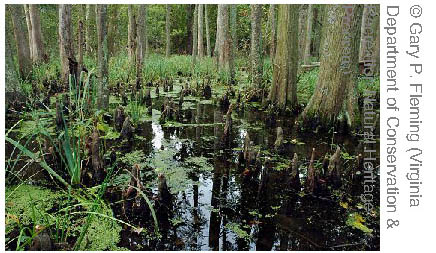

Regional distribution:
DC, DE, MA, MD, NJ, NY, PA, VA. 196,233 total acres of habitat, of which 30.0% is conserved.
Description:
A tidally flooded hardwood forest and shrubland in lower river floodplains and estuaries of the North Atlantic Coastal Plain. Deciduous hardwood species predominate, especially ash (green or pumpkin), black gum, or water tupelo, along with red maple, American elm, and black willow. Alder and silky dogwood are common shrubs. Lianas and vines are common: poison ivy, greenbrier, and Virginia creeper. Species richness in the herbaceous layer is exceptionally high due to microtopographic features. Regularly flooded hollows primarily support flood-tolerant swamp species such as orange jewelweed, arrow arum, and various smartweeds. Water hemlock, and smallspike false nettle are typical of elevated hummocks.
Download the
pdf for this habitat for information about species, crosswalks to state names, and condition of this habitat.
Central Atlantic Coastal Plain Non-riverine Swamp and Wet Hardwood Forest
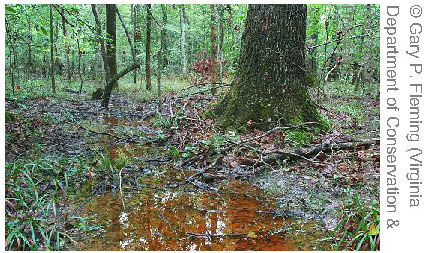

Regional distribution:
VA. 187,688 total acres of habitat, of which 37.2% is conserved.
Description:
A hardwood or mixed forested swamp on poorly drained soils of the outer Atlantic Coastal Plain that occurs in our region only in southeastern Virginia. Some ecologists identify 2 subgroups within this system: wetter examples that are dominated by bald cypress or tupelo, and drier ones with a significant component of bottomland oaks. Stands with a high cover of Atlantic white cedar formerly occupied much of the acreage of this system. Today this phase is present only in high-quality examples. A mostly nonriverine, non-seepage, non-tidal hydrology is a distinguishing factor for swamps in this system, which is the dominant habitat type in the Great Dismal Swamp in Virginia.
Download the
pdf for this habitat for information about species, crosswalks to state names, and condition of this habitat.
Southern Atlantic Coastal Plain Tidal Wooded Swamp
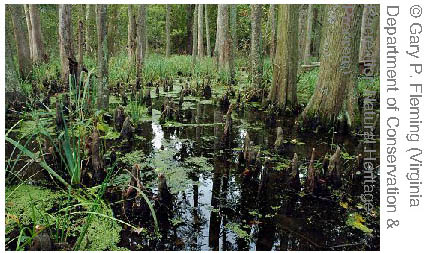

Regional distribution:
VA. 12,564 total acres of habitat, of which 32.9% is conserved.
Description:
A tidal swamp of the central and southeastern coastal plain, occurring only in southeastern Virginia in our region. Bald cypress, several species of tupelo, or green ash generally dominate. Swamps may be either regularly flooded by lunar tides or irregularly flooded by wind tides. Water salinity levels are often relatively low due to distance from the ocean and substantial freshwater inputs. Lower strata of vegetation are typically more diverse than inland swamps, containing species from those systems as well as a variety of shrubs and herbs shared with freshwater marshes.
Download the
pdf for this habitat for information about species, crosswalks to state names, and condition of this habitat.